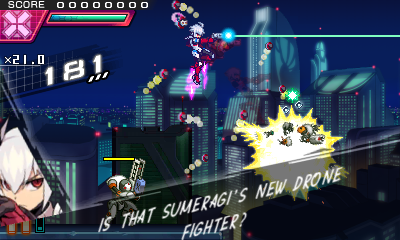Not Your Father's Mega Man Zero
If Mighty No. 9 is supposed to be a spiritual successor to Mega Man, then Azure Striker Gunvolt is the heir to the Mega Man Zero series. Despite the inspirations, Gunvolt and Gunvolt 2 still bring their own brand of fun and intense gameplay to the experience. Much like the first entry in the series, GV2’s strengths do not lie in the story. There are times where the plot feels like it only exists because Inti Creates felt like they needed something. The dialogue has its moments, but none of those moments come from essential plot builds. The real meat of GV2 lies in the expansion of Gunvolt’s established mechanics, and introducing an entirely new set of mechanics in our other hero, Copen.
Anyone who has experienced the first Azure Striker will need no time to adjust to the sequel; Gunvolt controls exactly as he did before. He can run, dash, shoot, and use his flash field to topple enemies. Striker’s gun works both as an attack and a tag. Each tag allows a bolt from GV’s flashield to hone in on the target to eradicate them. Learning how to combine both the flash field and gun is the key to making it through the experience. The game’s difficulty curve upticks almost immediately after the intro, so players need to learn quick. After defeating a boss, GV gains a new set of bolts (bullets), which can be theoretically used for different situations. These guns are exactly the same upgrades in the first title, which feels lazy, and most of these bolts pale in comparison to your default. Unlike your traditional run and gun, GV2 integrates a leveling system, which allows characters to gain HP and learn new skills. Leveling happens quick enough that grinding never feels like a chore. However, the game never gets tough enough to warrant going to previous levels for the sole purpose of grinding. As GV grows in strength, he also gains new offensive and defensive skills, which can turn the tide if used wisely.
Copen’s gameplay feels much faster and more exciting than GV’s. The only caveat is that Copen’s combat mechanics are so different than GV’s, it may take players a bit of time to get the hang of. Copen comes armed with a jetpack, allowing him to dash on the ground, air, and ricochet off of walls. Combined with his guns, Copen can ram into foes and rain bullets down upon them. Every time Copen’s dash makes contact with an enemy, he gains both another charge, and tags an enemy; something skilled players can take huge advantage of. Instead of new bullets, Copen’s spoils of war is a copy of the defeated boss’s ability. These powers feel much more versatile and useful than GV’s bullets, especially in the later half of his campaign. All of these abilities make Copen far more powerful than GV, which means his campaign is a fair bit easier than the Azure Striker’s. Every boss downed by GV was brought down twice as fast when up against Copen’s pistols. While Copen and GV share almost all of the same boss fights, they share fewer levels, so when the player switches campaigns, the experience won’t lose its luster. In a game that encourages repeated run-throughs, I certainly applaud the effort.
GV2 has also brought back the kudos system, which is Inti Creates’ scoring system. Aside from a higher self-esteem, a good score nets you parts and cash players can use to upgrade GV and Copen. Doing damage accumulates kudos, but being hit so many times before hitting a checkpoint or activating a skill will erase the kudos you’ve gained in that section. Players can adjust the number of hits the character can take before the counter resets, which increases or decreases their worth depending on their choice. That also means that GV veterans can return to the one-and-done kudos system that broke them in.
GV2’s plot feels like Inti Creates is just going through the motions. Events in the first game, character backstory, character relations, and events bridging the gap between the two titles are merely handled in one or two sentences, then never mentioned again. While the story stumbles, the dialogue is a significant step up from the first title. Some of the dialogue between GV’s ragtag group is a bit groan-worthy, but listening to the bosses’ over-the-top performance made up for it. On the other hand, no one knows when to shut up. Bosses talk almost the entire time they are in the fray. All of the dialogue is V/O’d, which is impressive, and I would find a bigger deal if I spoke and understood Japanese. Since English is my one and only language, I had to split my focus between dodging attacks and reading. To the game’s credit, there is an option to shut off the dialogue, letting players focus on the gameplay.
Azure Striker Gunvolt 2 is a solid improvement over the first; an impressive feat as the first title was already a solid game. Between GV and Copen, players will be occupied for awhile. GV2 also brings a few bonuses to the table. The same could not be said about the story, both the plot and the execution. Dialogue works best when fun and campy, but tends to fall apart when the mood turns more serious. Though the plot isn’t anything special, this doesn’t feel like the type of series people come into to get a good yarn. Fans of fast-paced platforming (especially those who look at Mega Man X and Zero fondly) should definitely pick this one up.
Review: Azure Striker Gunvolt 2 (3DS)
Great









